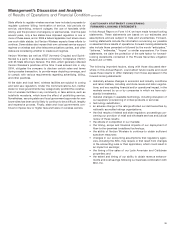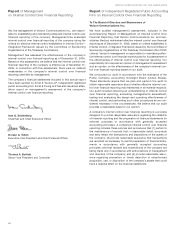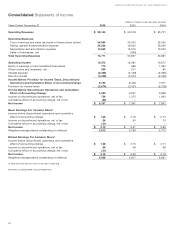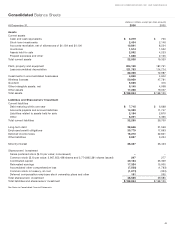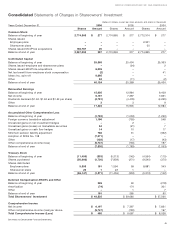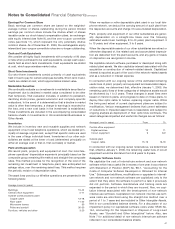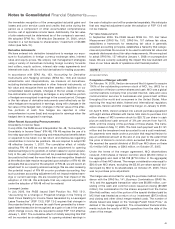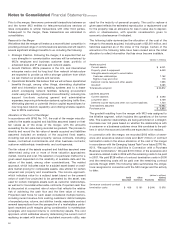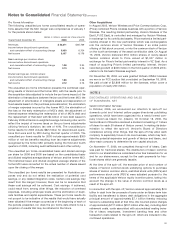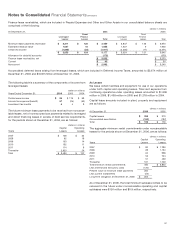Verizon Wireless 2006 Annual Report Download - page 50
Download and view the complete annual report
Please find page 50 of the 2006 Verizon Wireless annual report below. You can navigate through the pages in the report by either clicking on the pages listed below, or by using the keyword search tool below to find specific information within the annual report.
Notes to Consolidated Financial Statements continued
48
recoverability by comparing the carrying amount of the asset to the
net undiscounted cash flows expected to be generated from the
asset. If those net undiscounted cash flows do not exceed the car-
rying amount (i.e., the asset is not recoverable), we would perform
the next step which is to determine the fair value of the asset and
record an impairment, if any. We reevaluate the useful life determi-
nation for these intangible assets each reporting period to
determine whether events and circumstances warrant a revision in
their remaining useful life.
For information related to the carrying amount of goodwill by seg-
ment as well as the major components and average useful lives of
our other acquired intangible assets, see Note 7.
Income Taxes
Verizon and its domestic subsidiaries file a consolidated federal
income tax return.
Stock-Based Compensation
Effective January 1, 2006, we adopted SFAS No. 123(R), Share-
Based Payment utilizing the modified prospective method. SFAS
No. 123(R) requires the measurement of stock-based compensation
expense based on the fair value of the award on the date of grant.
Under the modified prospective method, the provisions of SFAS No.
123(R) apply to all awards granted or modified after the date of
adoption. The impact to Verizon primarily resulted from Verizon
Wireless, for which we recorded a $42 million cumulative effect of
accounting change as of January 1, 2006, net of taxes and after
minority interest, to recognize the effect of initially measuring the
outstanding liability for Value Appreciation Rights (VARs) granted to
Domestic Wireless employees at fair value utilizing a Black-Scholes
model. We have been expensing stock options since adopting
SFAS No. 123, Accounting for Stock-Based Compensation effective
January 1, 2003.
Foreign Currency Translation
The functional currency for all of our foreign operations is generally
the local currency. For these foreign entities, we translate income
statement amounts at average exchange rates for the period, and
we translate assets and liabilities at end-of-period exchange rates.
We record these translation adjustments in Accumulated Other
Comprehensive Loss, a separate component of Shareowners’
Investment, in our consolidated balance sheets. We report
exchange gains and losses on intercompany foreign currency trans-
actions of a long-term nature in Accumulated Other Comprehensive
Loss. Other exchange gains and losses are reported in income.
Employee Benefit Plans
Pension and postretirement health care and life insurance benefits
earned during the year as well as interest on projected benefit obli-
gations are accrued currently. Prior service costs and credits
resulting from changes in plan benefits are amortized over the
average remaining service period of the employees expected to
receive benefits.
As of July 1, 2006, Verizon management employees no longer earn
pension benefits or earn service towards the company retiree med-
ical subsidy (See Note 15).
In September 2006, the FASB issued SFAS No. 158, Employers’
Accounting for Defined Benefit Pension and Other Postretirement
Plans—an amendment of FASB Statements No. 87, 88, 106, and
132(R) (SFAS No. 158). SFAS No. 158 requires the recognition of a
defined benefit postretirement plan’s funded status as either an
asset or liability on the balance sheet. SFAS No. 158 also requires
Goodwill and Other Intangible Assets
Goodwill
Goodwill is the excess of the acquisition cost of businesses over
the fair value of the identifiable net assets acquired. Impairment
testing for goodwill is performed annually, and more frequently if
indications of impairment exist. The impairment test for goodwill
uses a two-step approach, which is performed at the reporting unit
level. We have determined that, in our case, the reporting units are
our operating segments since that is the lowest level at which dis-
crete, reliable financial and cash flow information is available. Step
one compares the fair value of the reporting unit (calculated using a
discounted cash flow method) to its carrying value. If the carrying
value exceeds the fair value, there is a potential impairment and
step two must be performed. Step two compares the carrying value
of the reporting unit’s goodwill to its implied fair value (i.e., fair value
of reporting unit less the fair value of the unit’s assets and liabilities,
including identifiable intangible assets). If the carrying value of
goodwill exceeds its implied fair value, the excess is required to be
recorded as an impairment.
Intangible Assets Not Subject to Amortization
A significant portion of our intangible assets are Domestic Wireless
licenses that provide our wireless operations with the exclusive
right to utilize designated radio frequency spectrum to provide cel-
lular communication services. While licenses are issued for only a
fixed time, generally ten years, such licenses are subject to renewal
by the Federal Communications Commission (FCC). Renewals of
licenses have occurred routinely and at nominal cost. Moreover, we
have determined that there are currently no legal, regulatory, con-
tractual, competitive, economic or other factors that limit the useful
life of our wireless licenses. As a result, we treat the wireless
licenses as an indefinite-lived intangible asset under the provisions
of SFAS No. 142, Goodwill and Other Intangible Assets (SFAS No.
142). We reevaluate the useful life determination for wireless
licenses each reporting period to determine whether events and cir-
cumstances continue to support an indefinite useful life.
We test our Domestic Wireless licenses for impairment annually,
and more frequently if indications of impairment exist. Beginning in
2005, we began using a direct value approach in performing our
annual impairment test on our Domestic Wireless licenses. The
direct value approach determines fair value using estimates of
future cash flows associated specifically with the licenses.
Previously, we used a residual method, which determined the fair
value of the wireless licenses by subtracting from the fair value of
the wireless business the fair value of all of the other net tangible
and intangible (primarily recognized and unrecognized customer
relationship intangible assets) assets of our wireless operations. We
began using the direct value approach in 2005 in accordance with a
September 29, 2004 Staff Announcement from the staff of the
Securities and Exchange Commission (SEC), “Use of the Residual
Method to Value Acquired Assets Other Than Goodwill.” Under
either the direct method or the residual method, if the fair value of
the aggregated wireless licenses is less than the aggregated car-
rying amount of the licenses, an impairment is recognized.
Intangible Assets Subject to Amortization
Our intangible assets that do not have indefinite lives (primarily cus-
tomer lists and non-network internal-use software) are amortized
over their useful lives and reviewed for impairment in accordance
with SFAS No. 144, whenever events or changes in circumstances
indicate that the carrying amount of the asset may not be recover-
able. If any indications were present, we would test for



